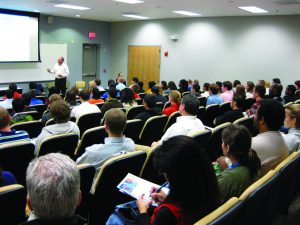
BTEC produced this meeting of ISPE’s NCSU student chapter, in which many of Biogen Idec’s professionals participated. (www.btec.ncsu.edu)
Well-designed education, training, and professional development programs and partnerships add considerable return on investment to stakeholders across the biopharmaceutical manufacturing industry. As biomanufacturers, suppliers, and regulatory bodies share similar workforce needs, focused education and training efforts can lead to increases in productivity, yield, and employee engagement and retention. In addition, education and training programs can decrease the incidence of deviations, which are costly to investigate and remediate. Yet when compared with other business needs, training, development, and human performance initiatives are all too often undervalued by leadership. Generating momentum for effective learning and development initiatives hinges on involvement from the right stakeholders.
In hopes of shedding light on the value of such training investments, this virtual roundtable format brings together a group of recognized learning, development, and business thought leaders within the biopharmaceutical manufacturing industry. Participating in this discussion are the following:
Ken Belanger, project manager, people and organization (Novo Nordisk)
John Wagner, program manager (Biotech Manufacturers Forum at NC
Biosciences Organization) and retired site manager (Merck Vaccines)
Mark Walter, director of training, Americas (Sartorius)
Amy Wilson, director of global biologics manufacturing and technical operations performance development (Biogen).

Students network and participate in group activities at the 2014 BTEC ISPE career fair. www.btec.ncsu.edu)
Valuing a Culture of Learning
BPI: As business leaders, why do you value learning and development?
Amy: People are the best and most important asset in an organization — they in fact make your organization what it is. Not providing learning and development opportunities for people is like owning a car and never doing anything to maintain it or make it better. The high value that I place on learning and development comes from my own growth experiences. Whether through formal training programs or informal mentorships, I know the difference that learning and development have made for me and my ability to contribute effectively. I want to extend these opportunities to others so that they can realize their potential.
Nothing about a focus on learning and development is a negative for an organization — it’s truly a win–win. It shows that you value your people, it enables people to do their work even better, and it provides knowledge and skills that people can take with them throughout their careers.
Ken: If you stop learning, you stop developing. In my previous experience and at Novo Nordisk, I observed how learning and development are critical factors in successful job performance. Attitude, mind-set, knowledge, and intellectual curiosity are the building blocks for learning, and application of those elements is the cornerstone of development. People who understand and apply that connection are very successful and develop into engaged, high-performing employees. I saw very clearly when this worked and when it didn’t. What convinced me was that those companies with strong L&D cultures had highly engaged employees collaborating in high-performing teams that exceeded their financial goals. Seeing that correlation was eye-opening for me.
Mark: Training is an investment and should not be viewed as a cost. The value of drug substance and/or drug product justifies the value of L&D that ultimately drives risk mitigation. For example, as a vendor providing single-use solutions, I know that disposable technologies require specific handling and use procedures. Without adequate employee training, deviations from manufacturer recommendations can increase the risk of failures and deviations — which come at a high cost.
Proper operator training and education in single-use technologies allow for mutual success for both vendors and end-users. When training programs are implemented, strong partnerships between both parties can develop easily.
John: As the plant manager during the start-up of a “megaplant,” I came to understand the delicate balance in the pace of training new employees. A coordinated training and development program includes the use of all the tools: on-the-job, hands-on, peer-to-peer, subject-matter–expert training, and internally developed process-specific programs; external programs through universities and specialized training companies that expose employees to a broader range of ideas and approaches. An employee’s understanding of his or her work falls into several levels.
Know the Job: First, you want employees to understand what the job tasks are and how to perform them repeatedly and reliably. This constitutes the basics, and all can be well when everything happens as planned.
Understand the Process: The next level is to understand “why” things are done the way they are, whether it be a production or business process. This level of training means that employees understand when something goes wrong and can perform basic troubleshooting to bring it back within the process parameters. Employees that have graduated to this level are able to execute tasks and, when things go wrong, correct them. Understand the Basic Science: In our industry, employees have many variables to consider and understand such as sterility, product and materials compatibility, and environmental conditions. People trained at this level can recognize and anticipate when a process is heading out of process parameters, preemptively correct it, and put actions in place to prevent recurrence. They also can make process changes to one aspect of the process without risking other parameters.
No organization has all employees trained to that highest level. Variations in competency level and attrition keep that from happening. Mature organizations have a healthy blend of employees at each of the levels. Getting to the right mix is an ongoing process. Moving employees through the hierarchy of levels involves exposing them to a process, on-the-job training, and appropriate educational opportunities.
Building a Business Case
BPI: What strategies, stakeholders, and data are critical toward building a business case for training?
Amy: Making a business case for training, especially in an operating environment, can be challenging. There is a notion that there is no time for training. Sometimes unfavorable experiences with training programs that have insufficiently supported performance improvement in the past automatically create a bias against training. What I have seen work well is to find one advocate — a sponsor who is willing to pave the way — and demonstrate value in his or her area. Good training will link directly to desired business results. Show those results with one program, and you can start to win others over.
As far as which stakeholders are critical to involve, I see this as both top-down and bottom-up. Again, the greatest challenge our operators express with respect to training is lack of time. This is a top-down issue that needs to be addressed. From a bottom-up perspective, the operators are your audience: What are their needs, and how can you help operators address them? In either case, listening to your business stakeholders is critical. You may have some great ideas or best practices you want to implement, but maybe those won’t actually help. Remember, it’s not about you, it’s about them. Training is a way to help them achieve their goals.
John: In my opinion, three different business cases can be made for training employees: safety, quality and compliance, and financial return. A case could be made that eventually safety and quality/compliance training leads to financial impact, but for this discussion let’s keep them separate.
Safety Training: Most safety training is traditionally done in-house, although with the movement toward behavioral-based safety, few internal programs are equipped with that expertise, so companies tend to look for outside providers. This is relatively easy to justify, and that justification is normally done by referencing industry-safety benchmarks.
Quality and compliance training is a blend of internal and external factors. As with safety, this is usually relatively easy to justify. Industry experts, technical thought leaders, and reputable training centers play an important role in this because of their credibility with regulators.
Financial justification can be trickier to offer because there are several ways to measure return. As a result, it’s going to be critical to involve stakeholders such as company/site financial leads, operations leads, and outside experts to tie results back to some kind of financial return, be it cost savings or cost avoidance.
Ken: The business case for training is all about employee engagement. People need to feel that they are contributing value and giving their best every day at work. Training can give people the knowledge and confidence they need to perform at their best every day. Employees are your most important stakeholders. And don’t forget the CFO as a key stakeholder, because she is the keeper of the financial funding you need to roll out successful programs. Other stakeholders are the educational partners in your community and in the town where you operate. They may be willing to offer you access to critical training resources.
The business case starts with employees: Highly engaged employees = great work environment/culture = happy customers = increased sales and profits. That is the cycle that most companies tend to prioritize in the wrong order.
Mark: Risk mitigation is critical to meeting project timelines. This becomes even more important when a company is implementing new technologies and modifying current technologies. In the case of single-use technologies for example, training by supplier subject-matter experts can help minimize unforeseen delays. In addition, personnel turnover and occurrences of supplier corrective action requests (SCARs) can indicate the need for refresher training.
Organizations
| Performance-improvement organizations mentioned in this article are the following: |
| ATD Association for Talent Development (www.td.org) |
| GMP TEA Good Manufacturing Practice Training and Education Association (http://gmptea.net/index.html) |
| ISPI International Society for Performance Improvement (www.ispi.org) |
| LTEN Life Sciences Trainers and Educators Network (www.l-ten.org) |

Trainees in the BARDA-sponsored course on advanced upstream processes for influenza vaccine manufacturing, held at the BTEC facility (www.btec.ncsu.edu)
Demonstrating Value
BPI: How does your training organization measure outcomes and demonstrate value? For example, can you correlate results of learning and development initiatives with changes in job performance?
Amy: Working for a large biologics manufacturer, I can say that each training program is designed to deliver unique value to the business. We recently started more formally developing a charter for each training program in which we outline the desired impact to the business. This is a measurable definition of success.
Ken: Our programs are evaluated in a number of ways. First, we have the traditional approach where a high percentage of all participants should rate a program as effective or highly effective. A second way is to evaluate how knowledge can be applied on the job, and we put this into the performance-management system, where outcomes are correlated with the training. Last, we encourage continuous learning through use of individual development plans, for which we encourage employees to look one to three years down the road and link training activities to competencies they want to develop for future roles. All of these approaches contribute to a strong learning and development culture at Novo Nordisk.
Mark: As a supplier to the biopharmaceutical industry, we’ve probably got a different perspective. It’s critical that our end-users are well trained on our products and consumables. We can monitor how well we have trained our customers through tracking complaint rates, noting reductions in product occurrences, and monitoring continuous communication with end-users. In the biopharmaceutical manufacturing industry, failures and deviations during processing require an increased work load and additional time and resources to meet target deadlines. As these stresses are minimized, it is common to see job performance increase.
Amy: At Biogen, we have a number of ways to evaluate job performance following learning and development initiatives. In task-based training, we observe performance as part of the qualification process and in some cases require periodic observation following that qualification. This helps us adjust training where required or provide additional coaching when we see job performance not meeting established standards. In the simplest case, however, we can directly ask people whether they are applying what they learned. This approach has been very successful in measuring our leadership development efforts.
John: Leadership skills are a good example. At the individual level, repeatedly observed changes in leadership behaviors can reveal increased confidence in the job. Confidence may stem from both technical training and through leadership development experiences. Although not all employees possess strong leadership skills, most are more willing to take on leadership roles, even informally, once they have a higher level of job mastery.
Identifying Best Practices
BPI: What resources can training departments in the biopharmaceutical manufacturing industry use to identify best practices and set benchmarks?
Amy: Benchmarking is critical. My first experience with training in the biopharmaceutical industry was sitting at a table with a binder of procedures and a checklist. I literally spent more than 20 hours reading documents for which I had no context even to understand. Several years later as a training manager, I wanted to do my best and began to seek out answers to the question, “What does good training look like?” I went to events held by the Association for Talent Development (ATD) events, joined the International Society for Performance Improvement (ISPI), and attended conferences. I saw very clearly that what good training looked like was not what we were doing. I’ve learned from many other industries as well. I once saw a presentation from a retailer that trains its staff in a simulated grocery store so they learn how to engage and interact with the stores they support. In touring a nuclear power plant, I saw its simulated control room and learned about how it challenges its operators with troubleshooting situations. I even visited a police academy and learned about how it manages readiness for duty following academy graduation with peer-to-peer accountability and how it handles ongoing refreshers and development. To make a long story short, we can learn from many other industries.
There is a wealth of organizations for learning- and performance improvement professionals. I suggest ISPI, ATD, LTEN, and GMP TEA as key organizations in which to get involved to identify best practices and set benchmarks (see the “Organizations” box). My experience has been that best practices more frequently come from outside of the biopharmaceutical industry.

Members of the China SFDA tour the BTEC facility on Feb. 23, 2011.
Ken: We can definitely learn from each other in various industry forums, HR member organizations, and conferences. Internally, companies can look across units and other countries to see what works best in certain contexts and apply those in their own units. My own view is that training departments should have a dedicated resource scouting the market externally and develop best practices internally to bring the best into the training organization.
Partnering for Success
BPI: Finally, it’s worth noting that relationships between suppliers and biomanufacturing companies have evolved from purely transactional forms to models that are more consultative and service oriented. Can you offer any thoughts on how joint training and professional development strategies can be mutually beneficial to both groups?
John: This is an important question to raise. Biomanufacturing processes are extremely complex and are influenced by a wide array of variables. Regulatory agencies expect management and control of a process from end to end. Lately, they have extended that definition further back into the supplier value chain. Implementing change management with suppliers, regardless of how trivially they think their product affects your product’s quality, is always a challenge. For it to work properly, relationships need to be participative and partnership based rather than purely business focused.
Training suppliers on the key attributes of your process helps them understand the impact their products have on your process (similar to the hierarchy of training employees). Likewise, if a biomanufacturer has better knowledge of a supplier’s product and process and associated limitations, it can make better decisions such as how it sets validation ranges and other parameters. Regulatory agencies are coming to expect this.
Amy: I believe that joint training and professional development strategies can be beneficial to both groups. Suppliers who provide effective training on use of complex equipment will become more attractive choices. We like to leverage factory-acceptance training (FAT) and/or site-acceptance training (SAT) — for which partnership with a supplier can be extremely valuable. Going beyond “this is what each button does” to jointly developing training in “this is how it works for my process” can go a long way in setting people up to be successful. Vendors should consider offering advanced training (including troubleshooting) and providing certification programs.
Mark: Biomanufacturing companies and suppliers share a common goal: success. Working in partnership with biomanufacturers builds trust in the relationship and efficiencies in the process. Our industry can improve far more efficiently when end-users increase their expertise in vendor products and when vendors increase their expertise in bioprocessing.
John Balchunas is BTEC’s assistant director of professional development programs (jebalchu@ncsu.edu), and S. Anne Montgomery is cofounder and editor in chief of BioProcess International.
